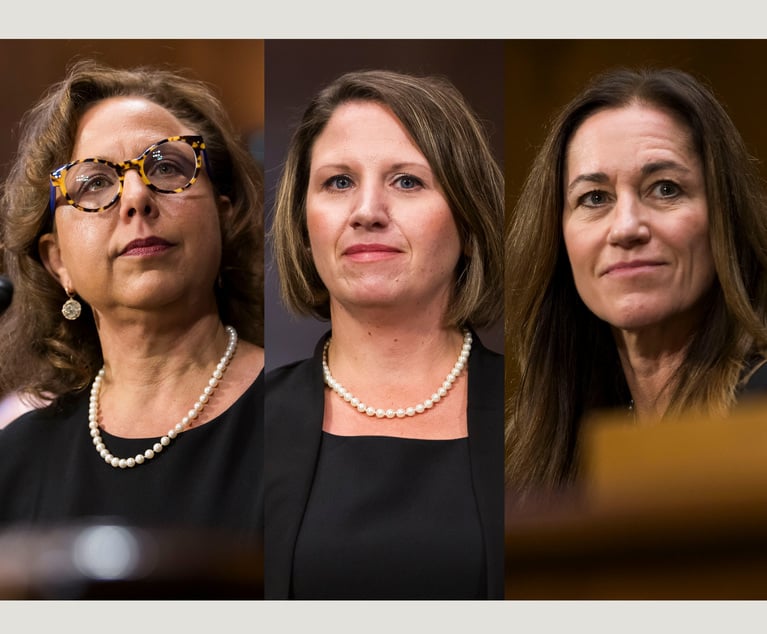Preservation: You Can't Produce What You Don't Have
The process of litigation actually begins well before a suit is ever filed. That's why it is so important to understand the rules of preservation as a part of the larger e-discovery picture.
March 15, 2019 at 02:07 PM
8 minute read
 Patrick Kennedy, Chamberlain Hrdlicka
Patrick Kennedy, Chamberlain HrdlickaIt only takes four little words to strike fear in the hearts of businesses everywhere: you have been sued. This is the first line in a stack of documents sent to someone, or their attorneys, when a lawsuit has been filed. The reality is, however, that the process of litigation actually begins well before a suit is ever filed. That's why it is so important to understand the rules of preservation as a part of the larger e-discovery picture.
Simply put, preservation is the process of making sure that any information relevant to a lawsuit, or pending litigation, is saved in a way that does not hinder the process of using that information during the discovery phase of a trial. Let's use that old journalism technique of the five ws to go through the process: who, what, when, where, and why (and we'll throw in that often overlooked h, as in “how,” just for kicks) of preservation. All of this is designed to help create and execute on a preservation plan by evaluating people, processes and software.
- Who
When preserving data, you have to figure out whose data is most relevant, and in e-discovery parlance, we call those people custodians. A custodian would be, for example:
- Anyone directly involved with the suit;
- Anyone with electronic or paper evidence that is potentially responsive to a discovery request; and
- External contractors or vendor personnel.
It is important to involve the right people when looking to preserve data. The list of people from whom you actually collect data may differ if an actual case moves forward, but when we are talking about preserving data so that it can be collected and reviewed, that list could be long.
- What
Once the who is decided, the next step is what. Specifically, what needs to be preserved? If you're on the defending side, a document called a litigation hold notice will detail exactly what the potential adversary is looking to preserve. If you're on the plaintiff's side, then you'll most likely be the one issuing the litigation hold notice.
Use the information from the Identify stage of the ILC process to help determine what data to preserve in the event of a lawsuit, and make sure this is spelled out in the litigation hold notice. Determining what data to preserve helps drive the process. For example, when looking to preserve email which is the first, but never the only, type of data to collect, take advantage of technology built it to Microsoft Exchange. Office 365 software has a graphical user interface that allows users to quickly identify mailboxes to preserve. This overrides the default MS Exchange setting, which is to delete items from the Retained Items folder after 14 days. This is a defensible method of preservation, ensuring your client is complying with the rules in a provable way in court.
- When
The temptation is to answer this particular “w” by saying simply “as soon as possible.” The FRCP actually does have recommendations on when to preserve data, however. The official statement is to begin preservation as soon as litigation “can be reasonably expected.” While this is a great guideline, I am an advocate of going back prior to what is expected to be requested during discovery as a buffer. More is definitely better at the preservation stage. As the document subtitle warns, you can't produce what you don't have.
If a hold notice has been issued, it will typically specify the time period that the potential adversary wants, but don't wait for this if you feel your client could be sued. As soon as you get a whiff of a lawsuit, put your preservation plan into place.
- Where
This particular question was answered fairly well in the ILC acronym: it's the l—locate the data. Essentially, your responsibility is to locate data that could potentially be responsive to litigation. Here, the focus is on potential. Preservation is one of those topics that occurs both prior to, and during litigation. For the purposes of this article, we are concentrating on the period of time before a lawsuit has been filed, but when it could be reasonably expected.
To that end, if you're writing the litigation hold notice on behalf of your client, be sure you're as thorough as possible about the types of data you're asking to be preserved (the what) and the places you expect the potentially opposing side to find it. Here, a wide net is again preferred, just be specific about the fish you're looking to catch.
Sidebar: Be aware of special provisions/legal language necessary to obtain a hold on personal phones. Most companies have policies governing the use of a personal phone for business, including reading company email. A few companies have a policy stating they can remotely wipe a personal device if corporate policies were violated or if there is a security breach. This would not only remove all personal data from a custodian's phone, but any potentially responsive information would no longer be preserved, which should be heavily considered when figuring out where data that needs to be preserved might live.
- Why
It is in fact the law that if you can reasonably assume litigation is imminent, you must begin the preservation process. It's good policy as a legal provider to make sure your clients are covered. Additionally, having and implementing a preservation plan makes you look like a fair player in the lawsuit to both judges and juries, and that matters! Defensibility in the e-discovery arena is what sets good law firms apart from mediocre ones.
Lastly, if you've properly preserved data, it makes things much easier from a review and production standpoint. A lot of the harder work has already been done, which saves time (and your client's money) on the other end if you actually do get that notice that you have been sued.
- How
The final question in your preservation plan involves how you actually go about preserving electronically stored information. As mentioned previously in this article, some software products like Microsoft Exchange have litigation hold modules built in. But there are a few other things that you can do that will make this particular question easier to answer:
- Understand your client's back-up policies and timelines so that you can be sure critical data isn't overwritten as a matter of routine course when backups of data “roll off” the schedule;
- Interview the following individuals: Your client's IT department head to get clarity on back-up schedules and procedures, and to create a list of applications that may store potentially responsive data, and custodians, to find out where they store their documents and how often they delete old emails and documents;
- Ask for a network diagram to physically locate servers (large entities will have this, smaller ones may not);
- People, process, software—using your list of people (your custodians), talk to them about what processes they follow (job description and duties) and what software applications they use: accounting staff will typically use specialized software (databases) like QuickBook and construction projects may use construction management software such as Primavera, Procore or Sage software.
Creating, maintaining and implementing a preservation plan is key to fast and accurate e-discovery. As attorneys and in-house e-discovery teams, your job is to ensure clients are ready, should litigation occur. Naturally, the other side of the coin is that as a prosecuting attorney, you need to be sure your client is at the ready with a plan to make sure the opposition is saving the information you may potentially need should you file the suit on your client's behalf.
Following the five ws, and the bonus “h” listed here, you should be well-equipped to handle potential legal conflicts. Properly preserved data is the key to a smooth litigation process!
Patrick Kennedy is the director of e-discovery for Chamberlain Hrdlicka, a multidiscipline law firm with offices in Philadelphia, Atlanta, Houston and San Antonio. Contact him at [email protected].
This content has been archived. It is available through our partners, LexisNexis® and Bloomberg Law.
To view this content, please continue to their sites.
Not a Lexis Subscriber?
Subscribe Now
Not a Bloomberg Law Subscriber?
Subscribe Now
NOT FOR REPRINT
© 2025 ALM Global, LLC, All Rights Reserved. Request academic re-use from www.copyright.com. All other uses, submit a request to [email protected]. For more information visit Asset & Logo Licensing.
You Might Like
View All
Pa. Federal District Courts Reach Full Complement Following Latest Confirmation

The Defense Bar Is Feeling the Strain: Busy Med Mal Trial Schedules Might Be Phila.'s 'New Normal'
7 minute read
Federal Judge Allows Elderly Woman's Consumer Protection Suit to Proceed Against Citizens Bank
5 minute read
Judge Leaves Statute of Limitations Question in Injury Crash Suit for a Jury
4 minute readTrending Stories
- 1We the People?
- 2New York-Based Skadden Team Joins White & Case Group in Mexico City for Citigroup Demerger
- 3No Two Wildfires Alike: Lawyers Take Different Legal Strategies in California
- 4Poop-Themed Dog Toy OK as Parody, but Still Tarnished Jack Daniel’s Brand, Court Says
- 5Meet the New President of NY's Association of Trial Court Jurists
Who Got The Work
J. Brugh Lower of Gibbons has entered an appearance for industrial equipment supplier Devco Corporation in a pending trademark infringement lawsuit. The suit, accusing the defendant of selling knock-off Graco products, was filed Dec. 18 in New Jersey District Court by Rivkin Radler on behalf of Graco Inc. and Graco Minnesota. The case, assigned to U.S. District Judge Zahid N. Quraishi, is 3:24-cv-11294, Graco Inc. et al v. Devco Corporation.
Who Got The Work
Rebecca Maller-Stein and Kent A. Yalowitz of Arnold & Porter Kaye Scholer have entered their appearances for Hanaco Venture Capital and its executives, Lior Prosor and David Frankel, in a pending securities lawsuit. The action, filed on Dec. 24 in New York Southern District Court by Zell, Aron & Co. on behalf of Goldeneye Advisors, accuses the defendants of negligently and fraudulently managing the plaintiff's $1 million investment. The case, assigned to U.S. District Judge Vernon S. Broderick, is 1:24-cv-09918, Goldeneye Advisors, LLC v. Hanaco Venture Capital, Ltd. et al.
Who Got The Work
Attorneys from A&O Shearman has stepped in as defense counsel for Toronto-Dominion Bank and other defendants in a pending securities class action. The suit, filed Dec. 11 in New York Southern District Court by Bleichmar Fonti & Auld, accuses the defendants of concealing the bank's 'pervasive' deficiencies in regards to its compliance with the Bank Secrecy Act and the quality of its anti-money laundering controls. The case, assigned to U.S. District Judge Arun Subramanian, is 1:24-cv-09445, Gonzalez v. The Toronto-Dominion Bank et al.
Who Got The Work
Crown Castle International, a Pennsylvania company providing shared communications infrastructure, has turned to Luke D. Wolf of Gordon Rees Scully Mansukhani to fend off a pending breach-of-contract lawsuit. The court action, filed Nov. 25 in Michigan Eastern District Court by Hooper Hathaway PC on behalf of The Town Residences LLC, accuses Crown Castle of failing to transfer approximately $30,000 in utility payments from T-Mobile in breach of a roof-top lease and assignment agreement. The case, assigned to U.S. District Judge Susan K. Declercq, is 2:24-cv-13131, The Town Residences LLC v. T-Mobile US, Inc. et al.
Who Got The Work
Wilfred P. Coronato and Daniel M. Schwartz of McCarter & English have stepped in as defense counsel to Electrolux Home Products Inc. in a pending product liability lawsuit. The court action, filed Nov. 26 in New York Eastern District Court by Poulos Lopiccolo PC and Nagel Rice LLP on behalf of David Stern, alleges that the defendant's refrigerators’ drawers and shelving repeatedly break and fall apart within months after purchase. The case, assigned to U.S. District Judge Joan M. Azrack, is 2:24-cv-08204, Stern v. Electrolux Home Products, Inc.
Featured Firms
Law Offices of Gary Martin Hays & Associates, P.C.
(470) 294-1674
Law Offices of Mark E. Salomone
(857) 444-6468
Smith & Hassler
(713) 739-1250





